Masonry's Past and Future Come to Life at the National Building Museum
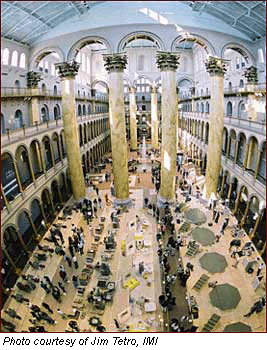 What is the future of masonry, as well as the future of skilled masonry craftsmanship? Two recent events in Washington, D.C., provided compelling answers to both questions.
What is the future of masonry, as well as the future of skilled masonry craftsmanship? Two recent events in Washington, D.C., provided compelling answers to both questions.
October was clearly "Masonry Month" at the National Building Museum, with the debut of the "Masonry Variations" exhibition, plus several events of the International Union of Bricklayers and Allied Craftworkers (BAC) and the International Masonry Institute (IMI), most notably the BAC/IMI International Apprentice Contest, the first in 40 years. Rounding out the program was the Masonry Mania Family Festival, with hands-on activities, educational exhibits and craft skills demonstrations in restoration and terrazzo.
The BAC/IMI International Apprentice Contest
For the contest, 30 top BAC apprentices competed in brick, stone, tile, marble, plaster and cement finishing. The winners were:
Brick - Steve Koontz, Cleveland, Ohio, BAC Local 5
Stone - Tim Cushey, Saxonburg, Penn., BAC Local 9
Plaster - Patricio Silva, Summit, Ill., BAC Local 56
Marble - Jeffrey Bloomfield, Rosemead, Calif., BAC Local 4
Tile - Gustavo Ayala, Port Hueneme, Calif., BAC Local 18
Cement - Matthew Barchett, Benton Harbor, Mich., BAC Local 9
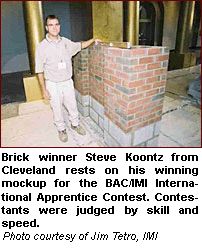 Each winner received a new Ford F-150 truck.
Each winner received a new Ford F-150 truck.
"The skill levels of all the contestants were really impressive," says BAC President and IMI Co-Chair John J. Flynn. "They are truly dedicated to their crafts. We are equally committed to investing in the future of quality masonry."
The "Masonry Variations" Exhibit
The future look of masonry is the subject of the "Masonry Variations" exhibition at the National Building Museum, America's premier cultural institution dedicated to exploring and celebrating architecture, design, engineering, construction and urban planning. "Masonry Variations," sponsored by BAC and IMI, explores the untapped potential of masonry, and offers designers this challenge: "If you can imagine it, we can build it."
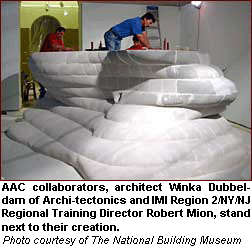 The purpose of the exhibition is twofold: to take masonry beyond the "traditional" use and see what else the materials can do, and to highlight the value of collaboration between those who design and those who make the designs real.
The purpose of the exhibition is twofold: to take masonry beyond the "traditional" use and see what else the materials can do, and to highlight the value of collaboration between those who design and those who make the designs real.
"Masonry Variations" involves the classic materials of stone, brick and terrazzo, plus a new one, Aerated Autoclaved Concrete, or AAC block. The challenge, launched by guest curator Stanley Tigerman, FAIA, of Tigerman McCurry Architects (Chicago), was to take common masonry materials in new directions, and to suggest the unexplored potential of each. The teams consisted of four renowned architects and expert IMI instructors.
The Terrazzo team of Los Angeles architect Julie Eizenberg of Koning Eizenberg Architecture and IMI Terrazzo Instructor Mike Menegazzi took raw shards of slate tiles and transformed them from a highly polished smoothness to an increasingly rugged texture, all while rising and undulating from the gallery floor.
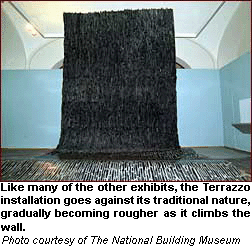 The Brick team offered a radical departure for the material, which for centuries has involved compression, stacked and bearing on one another. Houston architect Carlos Jim?nez of Carlos Jimenez Studio worked with IMI Southwest Regional Training Director Keith Behrens to challenge convention ? and defy gravity ? by creating interlaced and moveable armatures joined together in tension.
The Brick team offered a radical departure for the material, which for centuries has involved compression, stacked and bearing on one another. Houston architect Carlos Jim?nez of Carlos Jimenez Studio worked with IMI Southwest Regional Training Director Keith Behrens to challenge convention ? and defy gravity ? by creating interlaced and moveable armatures joined together in tension.
For stone, Chicago architect Jeanne Gang of Studio Gang Architects and IMI Special Projects Coordinator Matthew Redabaugh wanted to demonstrate the delicate balance between material and shape. They started with classic marble to create a new, translucent blend of stone, woven glass fiber, and resin, cutting it into thin, yet immeasurably strong, puzzle-shapes using computer modeling, and joining the pieces together. Again a departure from stone's traditional compression method, the result is a translucent marble curtain of 600 interlocking pieces that hang in tension from the vaulted gallery ceiling.
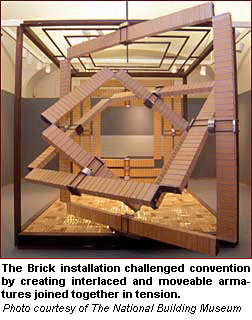 For the new material, AAC block, New York architect Winka Dubbeldam of Archi-tectonics worked with IMI Region 2 / NY / NJ Regional Training Director Robert Mion Jr. to explore its possibilities. AAC is one-third the density and weight of traditional concrete block, and is gaining popularity in the U.S. for both residential and commercial / institutional purposes. Dubbeldam's design called for sculpting the material based on the graphic patterns of sound waves of varying intensities. The installation involved two AAC columns, "Fatty" and "Slim," reaching to the ceiling of the exhibit space. Walking through the exhibit, visitors experience different sounds, depending on where they stand in relation to a monitor showing and airing the sounds.
For the new material, AAC block, New York architect Winka Dubbeldam of Archi-tectonics worked with IMI Region 2 / NY / NJ Regional Training Director Robert Mion Jr. to explore its possibilities. AAC is one-third the density and weight of traditional concrete block, and is gaining popularity in the U.S. for both residential and commercial / institutional purposes. Dubbeldam's design called for sculpting the material based on the graphic patterns of sound waves of varying intensities. The installation involved two AAC columns, "Fatty" and "Slim," reaching to the ceiling of the exhibit space. Walking through the exhibit, visitors experience different sounds, depending on where they stand in relation to a monitor showing and airing the sounds.
The installations are displayed in a series of galleries along with accompanying material describing the history of masonry techniques, changing methods of production, and possibilities for future uses. Lectures and hands-on design seminars will complete the program. Masonry Variations will be on view through April 4, 2004.
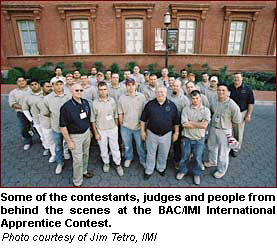 Beyond the principals of each team, each project involved significant team efforts, from the structural and aeronautical engineers called in to help the Stone piece perform correctly (and stay up!), to the dozens of IMI instructors who painstakingly selected and ground slate for the terrazzo or made the AAC "layer cakes," to others like Acme Brick Co. technical services engineer John Swink, who completed the brick's structural design under exhibit engineers - of - record Thornton - Tomasetti.
Beyond the principals of each team, each project involved significant team efforts, from the structural and aeronautical engineers called in to help the Stone piece perform correctly (and stay up!), to the dozens of IMI instructors who painstakingly selected and ground slate for the terrazzo or made the AAC "layer cakes," to others like Acme Brick Co. technical services engineer John Swink, who completed the brick's structural design under exhibit engineers - of - record Thornton - Tomasetti.
"It took a lot of courage to try it at all," says guest curator Stanley Tigerman. "There was no guarantee that any of them would work. Not only do they work, they look astounding, and they really have something to say for future design." The exhibit appealed to BAC and IMI for its emphasis on the future of masonry, and because of a strong belief in designer/craftworker collaboration, a hallmark of any successful building project.
"BAC and IMI believe that masonry's time-honored qualities of durability, beauty, scale, texture, flexibility and color have even more to offer," says IMI President Joan B. Calambokidis. "With this exhibition, we hope to inspire the masonry industry to look to its design future."
About the Author
Hazel Bradford is director of communications for the International Masonry Institute (IMI) and a former Washington correspondent for McGraw-Hill and ENR magazine.. The IMI is a strategic alliance of the International Union of Bricklayers and Allied Craftworkers and their signatory contractors, providing skilled craft training and technical assistance to the design and building communities.


















